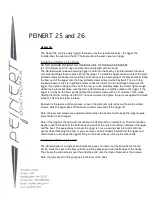
CS23 Owner’s Manual
2
-
21
R
ESPONSIBILITIES
AND
S
AFETY
Safety Alert From August 28, 2001:
The United States Coast Guard advised boaters
not to “Teak/Drag Surf.” Recent boating fatalities
revealed carbon monoxide (CO) emitted from a
vessel’s exhaust resulted in CO poisoning and
death. Do not allow persons in the vicinity of the
Swim Platform (in the water or in the boat) with the
engine(s) or generator operating, while at rest or
underway at slow speed. “Teak/Drag Surfing”
places the individual in a position directly exposed
to the CO in the engine’s exhaust. This can result in
a loss of coherent responses and even death. In
addition, “Teak/Drag Surfing” dangerously exposes
the individual to a possible propeller injury. Since
“Teak/Drag Surfing” is done without a life jacket
(PFD), it significantly increases the probability of
drowning. The Coast Guard stresses, “Teak/Drag
Surfing” is a very dangerous activity and advises
boaters not to participate in it.
The Coast Guard also stated that carbon monoxide
is one of the most dangerous gases. It strikes
before you know you are exposed and it impairs in
a way that can, and too often does, lead to death.
This is why the Coast Guard feels it is critical that
CO is avoided in every circumstance.
Navigation
Rules of the Road/Sound Signals
The General Prudential Rule regarding right-of-way
is that if a collision appears unavoidable, neither
boat has right-of-way. As prescribed in the “Rules
of the Road,” both boats must act to avoid collision.
The information in this section outlines only the
most basic of the nautical “Rules of the Road.” For
more information, contact your local USCG
Auxiliary.
In general, boats with less maneuverability have
right-of-way over more agile craft. You must stay
clear of the vessel with right-of-way and pass to his
stern.
Whistle/Horn Signals
Signaling other boats with a whistle or horn is
similar to using turn signals on an automobile. It is
not necessary to sound a signal every time a boat
is nearby. In general, boat operators should signal
their intention, as to avoid potentially confusing or
hazardous situations.
It is customary for the privileged boat to signal first,
and the burdened boat to return the same signal to
acknowledge she understands and will comply. Use
the danger signal (five or more short and rapid
blasts) if intent is not clear.
Use the following signal blast early enough to be
noticed and understood by other boaters:
• One long blast: Warning signal (coming out of
slip or passing astern)
• One short blast: Pass on my port side
• Two short blasts: Pass on my starboard side
• Three short blasts: Engines in reverse
• Five or more short and rapid blasts: Danger
signal!
Privileged Boats
Privileged boats have right-of-way and can hold
course and speed. Sailboats and boats paddled or
rowed have the right-of-way over motor boats.
Sailboats under power are considered motorboats.
Small pleasure craft must yield to large commercial
boats in narrow channels.
Burdened Boats
The burdened boat is the boat that must make the
necessary adjustment to course and speed to keep
out of the way of the privileged boat.
A
WARNING
Avoid injury, death or collisions. Like
traffic laws for automobiles, the operator
is legally required to follow the rules.
Содержание CS23
Страница 2: ...ii CS23 Owner s Manual COBAL T CS23 BOWRIDER ...
Страница 8: ...viii CS23 Owner s Manual COBAL T CS23 BOWRIDER NOTES ...
Страница 60: ...2 30 CS23 Owner s Manual COBAL T CS23 BOWRIDER SECTION 2 NOTES ...
Страница 102: ...3 42 CS23 Owner s Manual COBAL T CS23 BOWRIDER SECTION 3 NOTES ...
Страница 106: ...4 4 CS23 Owner s Manual COBAL T CS23 BOWRIDER SECTION 4 NOTES ...
Страница 128: ...6 10 CS23 Owner s Manual COBAL T CS23 BOWRIDER SECTION 6 NOTES ...
Страница 131: ...CS23 Owner s Manual 7 3 REFERENCE AND FORMS SERVICE LOG Date Hour Reading Service Repairs Performed ...
Страница 136: ...7 8 CS23 Owner s Manual COBAL T CS23 BOWRIDER SECTION 7 NOTES ...
















































